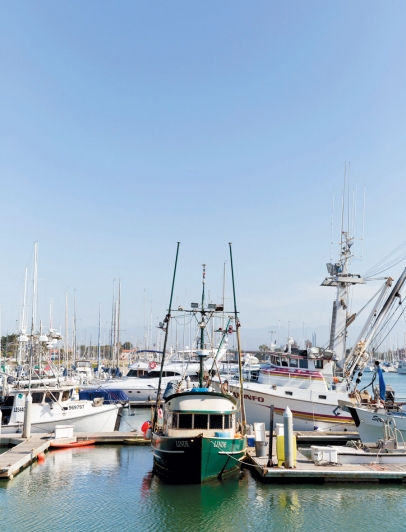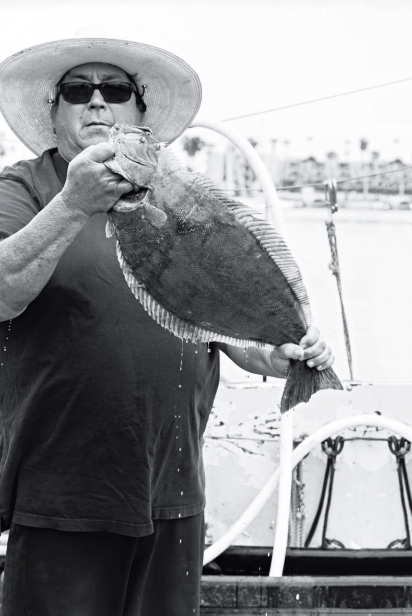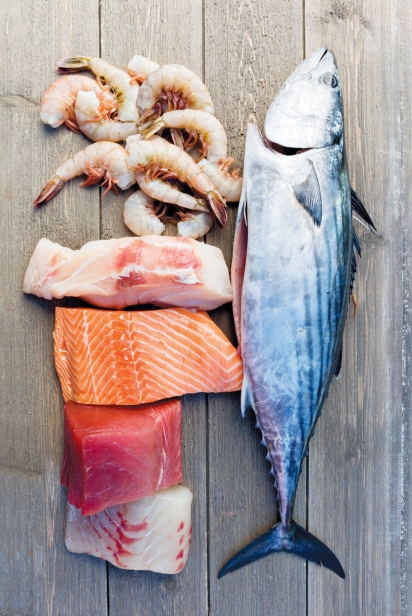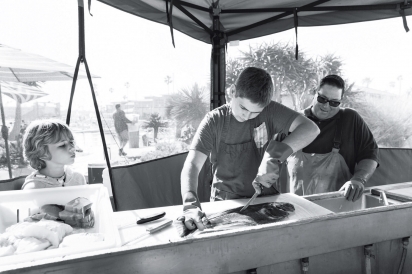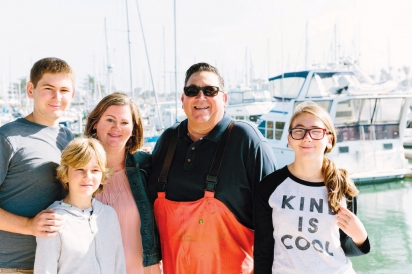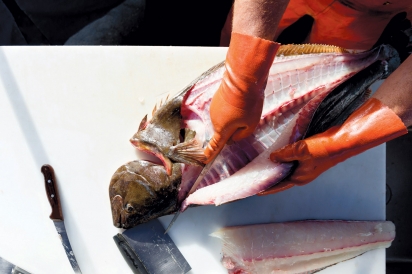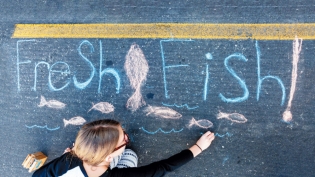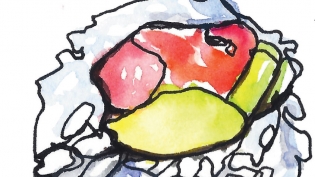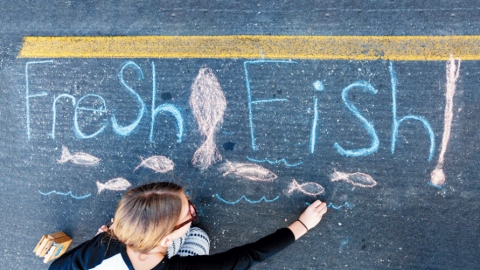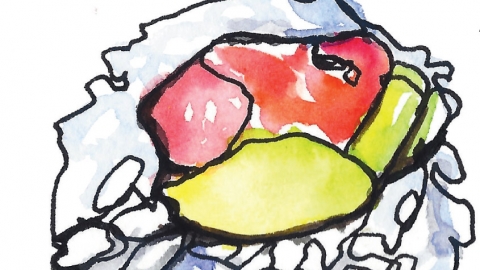A Commercial Fisherman: Reelin in the Years
Catching fish is only part of the story
The F/V Linde, 37 feet of battered steel and weathered rigging, doesn’t look like much, but she is. Her captain, Chris Williams, is built much like the Linde: sturdy and tough.
At 54, Chris is appreciably weathered, too. His skin is sun- and wind-blasted. His left hip is shot, so that, like the Linde, he moves with a decided sway. He uses a cane when he can, and eats Advil like candy.
Setting out from Fisherman’s Wharf at the Channel Islands Harbor, he sets nets for halibut and white sea bass, and fishes for swordfish with drift nets. Chris says he works hard to reduce bycatch by using specifically designed nets. Bycatch is unavoidable, but the amount is small, he says.
Commercial fishing breaks many. Those fishermen, they quit and find something else. The few that stick with it, they just wear out.
Chris has fished out of Channel Islands Harbor for 35 years. If, in that time, you have eaten at a local seafood restaurant, it could well have been Chris’s catch on your plate. But people don’t really think much about where the fish they’re eating comes from, do they?
Chris started as a deckhand. He worked for all manner of fishermen. He listened and learned. From the patient teachers. From the SOBs. You work like a dog, and you let nothing stop you. This bulldog approach doesn’t just apply to fishing.
When Chris and his wife, Dania, met, she was working on the boatyard’s receivables. Chris had two questions: Will you do my books? and Will you go out to dinner?
In a very real sense, Dania has been fishing out of Channel Islands Harbor for 17 years. A fisherman’s wife takes a fisherman’s life. There are times when Dania is driving in the truck, and she finds herself at the harbor. She sits in the parking lot thinking, Where was I supposed to go?
When their first child was born, Chris was there to welcome Max into the world. He left the day after Max came home from the hospital.
“I had to go swordfishing to pay the bills,” Chris will tell you. “Leaving Dania alone was pretty hard for me. But it was really hard for her. Thank God she’s a strong lady. If you’re not made out of iron, you can’t do this business.”
Dania is made of iron, though sometimes she puts her head back against the seat, and closes her eyes. She homeschools the kids. She basically does everything for Chris, except fish. Chris is at sea about 250 days a year. Dania sees the look in people’s eyes—a mother alone with three children. Poor thing. Where’s your husband?
Dania is with Max now. On this Thursday afternoon, Max has come along to help shovel 3,000 pounds of snowy-white ice from the bed of the truck into the hold of the Linde, because, like so many times before, his father will soon be right back on the water. Max is 16 now, his future only just bubbling in his brain. Ask him about his plans, and he’ll tell you he’s hoping to enlist in the Marines or the Navy. “Once I get out,” he says, “I figure I’ll be a fisherman.”
Seventeen years has brought three children—Max; Anna Grace, 12; and Micah, 9—and one family vacation.
“They’re wonderful kids,” Dania says. “They’ve had to fit into our weird life. It’s made them flexible. They rarely complain.”
You don’t need a calendar in the Williams household. You just look at the fish being offloaded. From February until June 15, Chris fishes halibut. From June 16 until around September, he fishes for white sea bass and halibut. From September until the end of January, he fishes swordfish with drift nets. Note the dearth of down time.
On this particular morning, he woke at 3:30am. During halibut season, Chris leaves Channel Islands Harbor in the darkness and returns to the dock by mid-afternoon. At night, he sleeps in his own bed. Halibut season is as close to normalcy as the Williams get. During the other fishing seasons, Chris can be gone for days at a time. When he comes in, it is often a matter of meeting him at the dock with fresh ice, clean clothes and food for the next trip. Which starts as soon as the fish are offloaded and the supplies are loaded on.
Sometimes weather keeps him in. Chris employs one deckhand. On about 20% of the trips, a government observer comes along. Southern California fishermen are some of the most heavily regulated fishermen on the planet. Aboard the Linde, three men sleep separated by no more than a good spit. Chris fished plenty of times alone, but when Max was born, Dania put the kibosh on that. She still dreads the nightmarish calls: It’s a little rough. You need to know my coordinates…
Fishermen call it the shoe, as in the lucky horseshoe. You have the shoe, or you don’t have the shoe. Chris has the shoe. He catches fish. It’s why he’s still out there.
“Ten percent of the guys catch 90% of the fish,” says Chris, easing back the throttle.
You have to guess where Chris falls.
Fishermen (and -women) are the last of this country’s hunter-gathers. Many are fascinated by their life on the sea. Every time Chris offloads fish, people gather to gawk and ask questions. But more than a few vilify commercial fishermen, seeing them as uncaring pillagers of the sea.
It is a complex matter, filled with gray areas. Scientific studies. Fish counts. Commercial fishermen shouting. Sport fishermen shouting. Environmentalists shouting. Federal and state bureaucracies mandating. Agendas on every side. You can drown in the words. It is hard to tell who is telling the truth. Or even if there is a truth. The oceans are a very big place, filled still with a host of unknowns.
If you are a Southern California fisherman, the topic of sustainability inhabits an outsized portion of your life.
Chris wends through the harbor, heading for the Linde’s slip.
“The regulations for fishermen have just gone crazy,” he says. “It’s probably resulted in about a 90% fleet reduction. Gone. Too expensive. Too hard. I’m all for resource protection, but every year they want more and more. You don’t want to whine and complain, but I feel like we’re a punching bag for every group and politician with an axe to grind. It gives you a little animosity after a while.”
“Regulations are necessary,” he continues, guiding the Linde into the slip. “You don’t want to take all the fish out of the sea. But I think that whole perception is way overblown. On the way home today, I probably saw five gray whales, and maybe 200 porpoises. The general perception, especially through the media and the environmental groups, is that everything’s dead. And it’s really quite the opposite. It’s really very healthy.”
Chris is not alone in his assessment.
“If you’re talking about the fish stocks in the ocean off Ventura County, things are generally quite healthy,” says Douglas McCauley, PhD, a professor of marine biology and ecology at the University of California, Santa Barbara. “The mean [average] view is that California’s waters as a whole are healthy. They’re in good shape. It’s when you start zooming out from our local waters, where you get into slightly messier space.”
McCauley is a scientist, who has some practical experience with fishing. As a youth, he worked summers on sportfishing boats out of San Pedro. His first job as a scientist was aboard commercial fishing boats in Hawaii, monitoring the catches of long-liners fishing for tuna and swordfish. His time with those fishermen left an impression.
“They’re extremely hardworking people,” says McCauley. “It’s a special job to be out there in the wild doing this. And they’re doing it essentially to push forward an industry that puts healthy, incredibly nutritious food on our plates. It’s critical for people in science and ocean management to work really closely with commercial fishers to make sure things stay sustainable. Commercial fishing is an important livelihood that could go extinct if we’re not careful.”
When it comes to sustainability, consumers can make the biggest difference of all. Unfortunately, no group is more battered and befuddled. Again, so many complexities. Farm-raised fish versus wild-caught fish. Groups presenting vastly different facts. Dire predictions of fishless oceans.
It freezes your brain, and your decision making.
“We hear these kind of eco-nightmare, broad blanket statements about our oceans and their depleting resources,” says Sarah Rathbone, cofounder of Dock to Dish in Los Angeles. “It makes people fearful, and they give up. Giving up is not how we’re going to make things more sustainable.”
Dock to Dish has a simple premise: Local restaurants serve what the local fishermen bring in. No costly carbon footprint, shipping fish halfway around the world. No supporting foreign fishing, whose practices, in many cases, are decimating the seas.
“It’s simply getting back to the essence of eating what’s in your own backyard,” says Rathbone, who works with Ventura County fishermen. “Being aware of your local seasonality and the sustainability of the seafood in your local waters.”
If you’re concerned about sustainability, buying your own fish, says Rathbone, is equally simple, especially here in Southern California where you can buy fresh fish right off the boat. Go to your local fish market. In general, says Rathbone, supermarket chains sell mostly imported fish. Ask a few simple questions: What is this fish? Where is it from? Is it farmed or wild? When was it caught? If you want to do right, but you’re shy about asking questions, here’s the one thing you need know: “If you buy U.S. fish, and it’s wild caught, you’re making a sustainable decision,” says Rathbone.
Note that it won’t be your cheapest buy.
It’s the hard math the Williams family faces every day. Less expensive swordfish that comes from drift gillnets in Chile or Peru, where there is less regulation on nets and bycatch, or fresh-caught local halibut for $22 a pound? One price based on little to no regulation, and, yes, the ravaging of the seas. The other price based on regulations that cost the Williamses thousands of dollars a year, but keeps fish stocks sustainable. On Sundays, Dania sells their fish at the Channel Islands Harbor Farmers’ Market beneath a jaunty Fresh Fish Fanatics banner. Sometimes she sees the sticker shock on the faces.
“People don’t know,” she sighs. “And about half of them don’t care. I get that. They’ve got a budget. But I think if they really knew, they would care.”
Chris just keeps fishing. Day by day. He adjusts to the regulations. He adjusts to the weather. He pulls fish over the side of his boat. He wakes in the dark. Sometimes at home. More often, rocking on the water. He will miss birthdays, holidays and anniversaries. He will spend them with one or two strangers, and the kids’ photos affixed to the wheelhouse walls.
That Max is interested in fishing piques the fisherman’s interest. But Chris Williams is a father first.
“I’m all for it, if he wants to do it,” Chris says. “I want him to do what fulfills him. What makes him feel like I feel when I do well fishing. That’s what I want for my kids, in whatever way that comes.”
At the helm of the Linde, Chris picks up a photo of the kids.
“I can’t believe how fast they grow up,” he says.
The future always looms. The future of commercial fishermen. The future of the seas. The future of children.
Chris puts the photo down, and turns back to the water.


